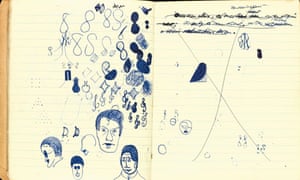
The notebooks, complete with the author's notes and doodles,
cover more than 700 pages including passages that were cut for the 1938 publication.
Photograph: Sotheby's/PA
Samuel Beckett's Murphy draft bought by Reading University for £1m
Draft of author's first published novel sells at Sotheby's to team led by Beckett's friend and biographer James Knowlson
The 100 best novels / No 61 / Murphy by Samuel Beckett (1938)
Clarice Armitstead
Wednesday 10 July 2013
Reading University has become the new owner of "almost certainly the most important English language manuscript still in private hands", after paying nearly £1m for a six-notebook draft of Samuel Beckett's first published novel, Murphy.
There was euphoria in book-dealing circles as the three-man university team - led by Beckett's friend and biographer James Knowlson – clinched the acquisition at £962,500.
Auction house Sotheby's had estimated its value at £800,000 to £1.2m. Rare book dealer Rick Gekoski, who was at the sale, said the university had bought at "a very reasonable price". He added: "It's amazingly important because Murphy is a great novel and it's so different to the final edition. It has a third more material. It's an absolutely intimate exposure of Beckett's creative methods."
The manuscript has rarely been seen since Beckett gave it to his friend Brian Coffey in 1938 to thank him for his support after the writer was stabbed in a random attack by a pimp in a Paris street as he was revising the proofs.
It was sold on in 1968 to a private collector, who kept it under lock and key until his death last year.
Mark Nixon, who heads Reading University's Beckett International Foundation and was among the team bidding for the manuscript, said: "I'm still a little bit speechless. One never knows for sure who one is bidding against at these things, but the competition has traditionally been from the US. Obviously not only for Beckett studies but for the whole of 20th century literature studies this is one of the most important manuscripts, and it has been locked away for 55 years. For scholars now to have access to it is very exciting."
Murphy – originally called Sasha Murphy – is unique among Beckett's work in that it is a London novel, about a young Irishman trying to follow his dreams in the city, and has a clear debt to an English literary tradition stretching back to Dr Johnson, Sterne and Swift.
Beckett began it in 1935 while in London to undergo a course of psycho-analysis. He was working through the proofs in Paris when the stabbing landed him in hospital, where Coffey and James Joyce were two of his most regular visitors.
In one of the notebooks, said Nixon, he lists dozens of publishers he submitted it to before it was accepted for publication, and "gives up after Faber and Faber".
The manuscript also shows him struggling to find an opening for the novel. "He starts eight times in the first notebook before he gets going," said Nixon. The first 11 pages of text are entirely crossed out, and the eight cancelled versions of the novel's famous opening sentence see him working his way from "The sun shone, as only the sun can, on nothing new" to the definitive line: "The sun shone, having no alternative, on the nothing new."
Nixon added: "It also has the most astonishing array of doodles and they are more extensive and clearer than anywhere else in his work." Charlie Chaplin – inspiration for the tramps in Waiting for Godot – appears in them, as does James Joyce, who visited Beckett daily in hospital in Paris.
It was a later friendship that led to Reading University becoming the world centre of Beckett studies. It began when James Knowlson, a young academic working in the French department, decided to mount a Beckett exhibition, after the writer was awarded a Nobel prize for literature in 1969.
Nixon said: "At the time we only had six books in the collection so Beckett would give him things and Jim would drive them back to England. So the entire original collection was donated by Beckett himself. Then in 1971 it was decided to make it into a permanent collection, and other practitioners started to hand things over too."
The Beckett International Foundation is a charity owned by the university, which only made the decision to bid for the Murphy manuscript at the very last minute. A spokesman said: "We're able to fund it through a bit of juggling of our finances. We have a very large holding of artwork in other collections, but the Beckett collection is the jewel in the crown, which is why we've made the decision to make this investment to get it back into the public realm."
The Routledge editor who finally accepted Murphy, in December 1937, said he "enjoyed it immensely. I want to publish it … it is far too good to be a big popular or commercial success … [but] will bring great joy to the few."






No comments:
Post a Comment